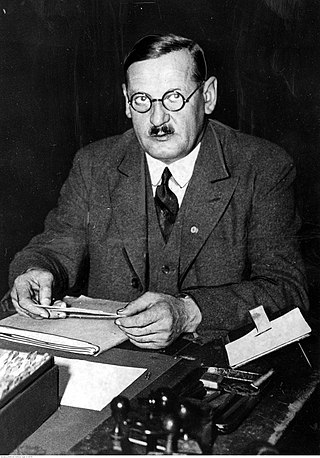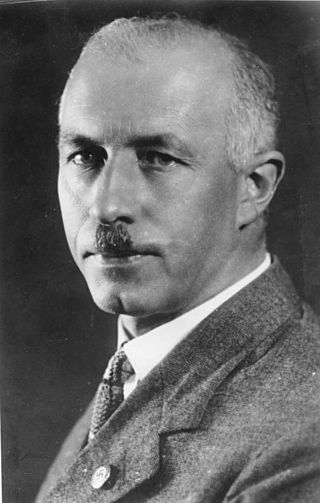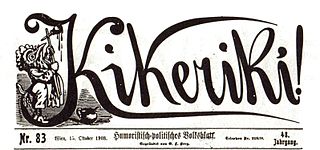
Anton Drexler was a German far-right political agitator for the Völkisch movement in the 1920s. He founded the German Workers' Party (DAP), the pan-German and anti-Semitic antecedent of the Nazi Party (NSDAP). Drexler mentored his successor in the NSDAP, Adolf Hitler, during his early years in politics.

The Nazi Party, officially the National Socialist German Workers' Party, was a far-right political party in Germany active between 1920 and 1945 that created and supported the ideology of Nazism. Its precursor, the German Workers' Party, existed from 1919 to 1920. The Nazi Party emerged from the extremist German nationalist, racist and populist Freikorps paramilitary culture, which fought against communist uprisings in post–World War I Germany. The party was created to draw workers away from communism and into völkisch nationalism. Initially, Nazi political strategy focused on anti–big business, anti-bourgeois, and anti-capitalist rhetoric; it was later downplayed to gain the support of business leaders. By the 1930s, the party's main focus shifted to antisemitic and anti-Marxist themes. The party had little popular support until the Great Depression, when worsening living standards and widespread unemployment drove Germans into political extremism.

The German Workers' Party was a short-lived far-right political party established in Weimar Germany after World War I. It only lasted from 5 January 1919 until 24 February 1920. The DAP was the precursor of the Nazi Party, which was officially known as the National Socialist German Workers' Party.

The Thule Society, originally the Studiengruppe für germanisches Altertum, was a German occultist and Völkisch group founded in Munich shortly after World War I, named after a mythical northern country in Greek legend. The society is notable chiefly as the organization that sponsored the Deutsche Arbeiterpartei, which was later reorganized by Adolf Hitler into the National Socialist German Workers' Party. According to Hitler biographer Ian Kershaw, the organization's "membership list ... reads like a Who's Who of early Nazi sympathizers and leading figures in Munich", including Rudolf Hess, Alfred Rosenberg, Hans Frank, Julius Lehmann, Gottfried Feder, Dietrich Eckart, and Karl Harrer.

Gottfried Feder was a German civil engineer, a self-taught economist, and one of the early key members of the Nazi Party and its economic theoretician. One of his lectures, delivered on 12 September 1919, drew Adolf Hitler into the party.

Karl Harrer was a German journalist and politician, one of the founding members of the German Workers' Party (DAP) in January 1919, the predecessor to the Nationalsozialistische Deutsche Arbeiterpartei, more commonly known as the Nazi Party.
National Socialist Party most often refers to the National Socialist German Workers' Party, commonly known as the Nazi Party, which existed in Germany between 1920 and 1945 and ruled the country from 1933 to 1945. However, similar names have also been used by a number of other political parties around the world, with various ideologies, some related and some unrelated to the NSDAP.

Rudolf Jung was a Nazi theoretician and the head of the German Bohemian Nazi movement from 1926 to 1933 before he immigrated to Germany. He joined the Nazi Party, was made an Honorary Gauleiter and became an SS-Gruppenführer. After the end of the Second World War, he was arrested and imprisoned by the Czechoslovak government but committed suicide before he could be brought to trial.

Hans Krebs was an ethnic German born in Moravia who was an ardent German nationalist who emigrated to Nazi Germany. He joined the Nazi Party, was elected to the Reichstag and was appointed a Regierungspräsident in the Sudetenland. He was also a member of the SS, rising to the rank of SS-Brigadeführer. In 1947, Krebs was executed in Prague for high treason by the Czechoslovak Republic.

Hans Knirsch was an Austro-German activist from Moravia for Austrian Nazism. After the breakup of the Austro-Hungarian Empire, he led the original party in Bohemia, called the German National Socialist Workers' Party. Together with Rudolf Jung and Hans Krebs, he was one of the original core that remained in the Nazi Party after 1933.

Austrian Nazism or Austrian National Socialism was a pan-German movement that was formed at the beginning of the 20th century. The movement took a concrete form on 15 November 1903 when the German Worker's Party (DAP) was established in Austria with its secretariat stationed in the town of Aussig. It was suppressed under the rule of Engelbert Dollfuss (1932–34), with its political organization, the DNSAP banned in early 1933, but was revived and made part of the German Nazi Party after the German annexation of Austria in 1938.
This is a list of words, terms, concepts and slogans of Nazi Germany used in the historiography covering the Nazi regime. Some words were coined by Adolf Hitler and other Nazi Party members. Other words and concepts were borrowed and appropriated, and other terms were already in use during the Weimar Republic. Finally, some are taken from Germany's cultural tradition.

The Sudeten German Party was created by Konrad Henlein under the name Sudetendeutsche Heimatfront on 1 October 1933, some months after the First Czechoslovak Republic had outlawed the German National Socialist Workers' Party. In April 1935, the party was renamed Sudetendeutsche Partei following a mandatory demand of the Czechoslovak government. The name was officially changed to Sudeten German and Carpathian German Party in November 1935.
The German National Socialist Workers' Party was a protofascist party of Germans in Czechoslovakia, successor of the German Workers' Party (DAP) from Austria-Hungary. It was founded in November 1919 in Duchcov. The most crucial party activists were Hans Knirsch, Hans Krebs, Adam Fahrner, Rudolf Jung and Josef Patzel. In May 1932, it had 1,024 local chapters with 61,000 members.

Austria was part of Nazi Germany from 13 March 1938 until 27 April 1945, when Allied-occupied Austria declared independence from Nazi Germany.
Dr. Walter Riehl was an Austrian lawyer and politician who was an early exponent of Austrian National Socialism. Belonging to the wing of that ideology that favoured links between Germany and an independent Austria, he lost influence as the drive for Anschluss grew within both Austrian National Socialism and German Nazism.
Politischer Arbeiter-Zirkel was a political activist group founded by Karl Harrer, a known nationalist, in hopes of gathering intellectuals to discuss the political future of Germany in March 1918. The organization eventually merged with the Workers' Committee for a Good Peace formed by Anton Drexler to become the German Workers' Party in January 1919. Ultimately these principles would develop into the National Socialist German Workers' Party, also known as the Nazi Party.

The Kikeriki (Cock-a-doodle-do) was a satirical magazine published in Vienna, Austria, between 1861 and 1933.













